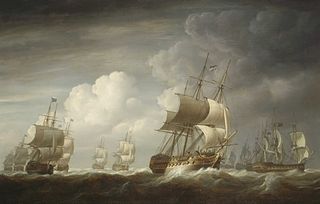Royal Admiral was an East Indiaman, launched in 1777 on the River Thames. She made eight trips for the East India Company (EIC) before she was sold. She then continued to trade. She made two trips carrying convicts from England to Australia, one as an East Indiaman in 1791, and a second in 1800. On this second voyage as a convict transport she was present at a notable naval action.
Albion was an East Indiaman of the British East India Company (EIC). She made eight voyages for the EIC before she was sold to the British government in 1810 for service as a troopship. She was lost at sea in 1816.
Airly Castle, was built by William Barnard at Deptford and launched in 1787. She made eight voyages as an East Indiaman for the British East India Company (EIC) between 1788 and 1808. In 1795 she participated in the capture of seven Dutch East Indiamen near St Helena. After her eight voyages she may have served briefly as a general transport before she was sold for breaking up in 1810. She was not broken up but instead served as a transport for several years.

Rockingham was launched as an East Indiaman in 1785. She made seven voyages for the British East India Company (EIC) between 1786 and 1802 before she was sold for breaking up.
Ponsborne was launched in 1779 as an East Indiaman for the British East India Company (EIC). She made six voyages for the EIC before she was wrecked in 1796 at Grenada after having landed troops there.
Woodcot was launched in 1786 as an East Indiaman for the British East India Company (EIC). She made four voyages for the EIC. The French captured her in 1798 at Tellicherry as she was homeward bound from her fifth voyage. American owners purchased her, renamed her Berkshire, and sailed her to Bombay in 1799.
Britannia was launched by the Bombay Dockyard in 1772, and was rebuilt in 1778. The British East India Company (EIC) apparently acquired her in 1775. Between 1779 she made eleven complete voyages as an East Indiaman for the EIC. She also participated in three naval campaigns, during the first of which she was deployed as a cruiser off Sumatra. There she engaged and captured a French ship. In the other two she served as a transport. She set out for her twelfth EIC voyage but was lost in 1805 during the third naval campaign.

Lord Hawkesbury was launched in 1787 as an East Indiaman for the British East India Company (EIC). She made eight voyages for the EIC before she was sold in 1808 for breaking up.
Contractor was launched in 1779 as an East Indiaman. She made seven voyages for the British East India Company (EIC). She made one voyage as a transport for a military expedition before her owners sold her in 1800 for use as a transport.
Dublin was launched in 1784 as an East Indiaman. She made six voyages for the British East India Company (EIC), to India and China. On her last voyage for the EIC she recaptured a country ship. Her owners sold Dublin in 1800 and she became a West Indiaman, but apparently was lost on her first voyage.
Duke of Montrose was launched in 1785 as an East Indiaman. She made eight voyages for the British East India Company (EIC). She then briefly became a troop transport, sailing to the West Indies. She was sold in 1811 for breaking up.
Earl of Wycombe was launched in 1786 as an East Indiaman. She made six voyages for the British East India Company (EIC). In 1800 she became a general trader, trading across the Atlantic to the West Indies and Canada. She was lost without a trace c.1803.

Essex was launched in 1780 as an East Indiaman. She made six voyages for the British East India Company (EIC). On her first voyage she was present at an inconclusive battle with the French, and later at a second inconclusive engagement with a French frigate. In 1798 she was sold to be hulked or broken up.

True Briton was launched in 1790 as an East Indiaman for the British East India Company (EIC). She was lost without a trace in 1809 during her eighth voyage.
Sulivan, was launched 1782 as an East Indiaman. She made five voyages for the British East India Company (EIC), and twice participated as a transport for military expeditions. Her owners sold her to an American and she became the British-registered vessel Washington. She was involved in a single-ship action with a French privateer shortly after her sale. She traded with America until 1805 when she was sold for breaking up.
Worcester was launched in 1785 as an East Indiaman for the British East India Company (EIC). She made eight voyages to India and China for the EIC and participated as a transport in two naval expeditions before she was sold in 1809 for breaking up.

Belvedere was launched in 1787 at Itchenor. She made six voyages for the British East India Company (EIC). She then briefly sailed as a West Indiaman. She was broken up by 1805.
Thetis was launched on the river Thames in 1786 as an East Indiaman. She made six voyages for the British East India Company between 1787 and 1800, She then was sold and spent a handful of years as a West Indiaman. She was broken up in 1806.
London was launched in 1779 as an East Indiaman. She made seven voyages for the British East India Company (EIC), between 1780 and 1798. She was sold for breaking up in 1799.
Warren Hastings was launched in 1781 as an East Indiaman for the British East India Company (EIC). She made six voyages for the EIC before being sold in 1797 for breaking up.




